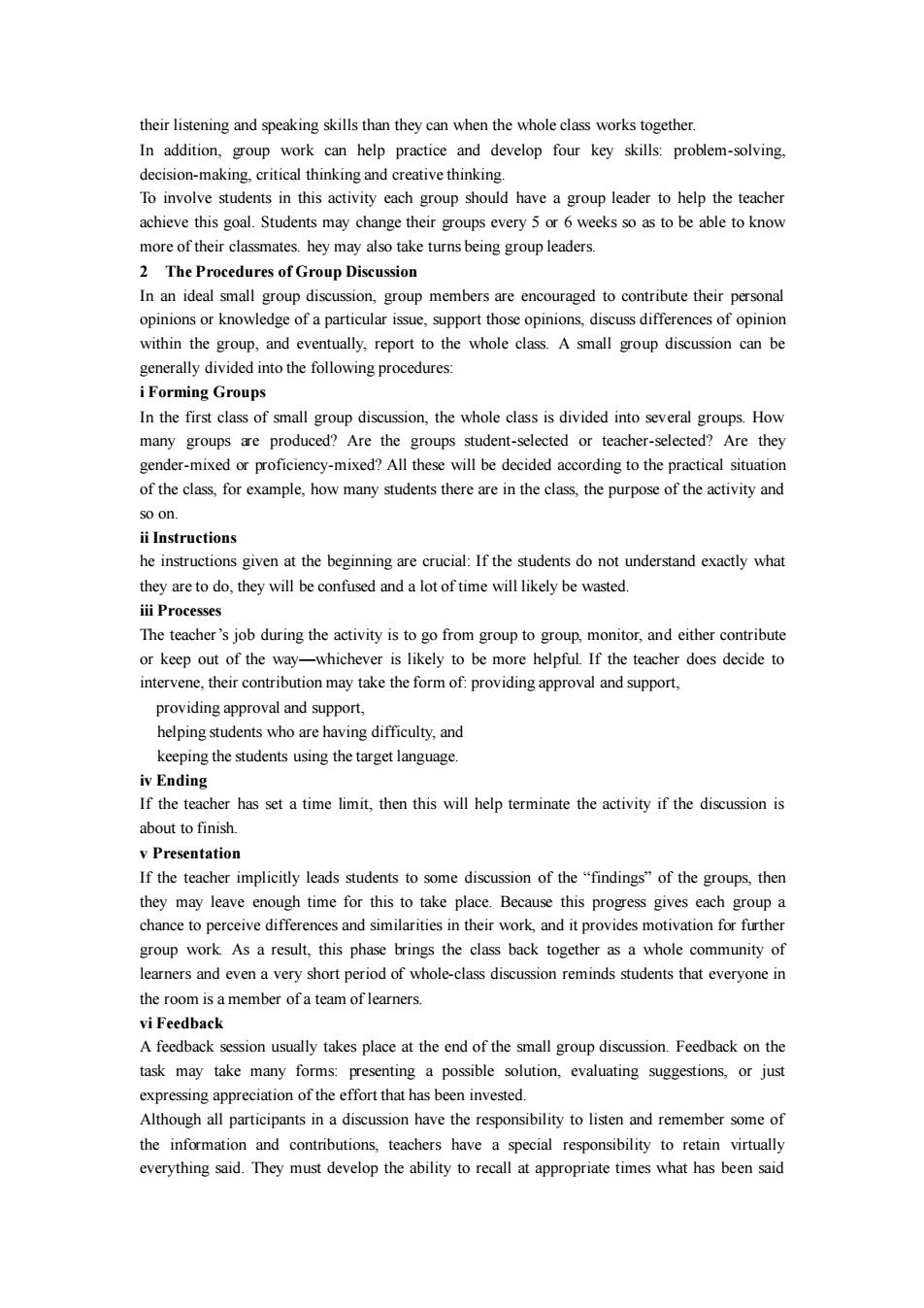正在加载图片...

their listening and speaking skills than they can when the whole class works together. In addition,group work can help practice and develop four key skills:problem-solving, decision-making,critical thinking and creative thinking. To involve students in this activity each group should have a group leader to help the teacher achieve this goal.Students may change their groups every 5 or 6 weeks so as to be able to know more of their classmates.hey may also take turns being group leaders. 2 The Procedures of Group Discussion In an ideal small group discussion,group members are encouraged to contribute their personal opinions or knowledge of a particular issue,support those opinions,discuss differences of opinion within the group,and eventually,report to the whole class.A small group discussion can be generally divided into the following procedures: i Forming Groups In the first class of small group discussion,the whole class is divided into several groups.How many groups are produced?Are the groups student-selected or teacher-selected?Are they gender-mixed or proficiency-mixed?All these will be decided according to the practical situation of the class,for example,how many students there are in the class,the purpose of the activity and so on ii Instructions he instructions given at the beginning are crucial:If the students do not understand exactly what they are to do,they will be confused and a lot of time will likely be wasted. iii Processes The teacher's job during the activity is to go from group to group,monitor,and either contribute or keep out of the way-whichever is likely to be more helpful.If the teacher does decide to intervene,their contribution may take the form of:providing approval and support, providing approval and support, helping students who are having difficulty,and keeping the students using the target language. iv Ending If the teacher has set a time limit,then this will help terminate the activity if the discussion is about to finish. v Presentation If the teacher implicitly leads students to some discussion of the "findings"of the groups,then they may leave enough time for this to take place.Because this progress gives each group a chance to perceive differences and similarities in their work,and it provides motivation for further group work.As a result,this phase brings the class back together as a whole community of learners and even a very short period of whole-class discussion reminds students that everyone in the room is a member of a team of learners vi Feedback A feedback session usually takes place at the end of the small group discussion.Feedback on the task may take many forms:presenting a possible solution,evaluating suggestions,or just expressing appreciation of the effort that has been invested. Although all participants in a discussion have the responsibility to listen and remember some of the information and contributions,teachers have a special responsibility to retain virtually everything said.They must develop the ability to recall at appropriate times what has been saidtheir listening and speaking skills than they can when the whole class works together. In addition, group work can help practice and develop four key skills: problem-solving, decision-making, critical thinking and creative thinking. To involve students in this activity each group should have a group leader to help the teacher achieve this goal. Students may change their groups every 5 or 6 weeks so as to be able to know more of their classmates. hey may also take turns being group leaders. 2 The Procedures of Group Discussion In an ideal small group discussion, group members are encouraged to contribute their personal opinions or knowledge of a particular issue, support those opinions, discuss differences of opinion within the group, and eventually, report to the whole class. A small group discussion can be generally divided into the following procedures: i Forming Groups In the first class of small group discussion, the whole class is divided into several groups. How many groups are produced? Are the groups student-selected or teacher-selected? Are they gender-mixed or proficiency-mixed? All these will be decided according to the practical situation of the class, for example, how many students there are in the class, the purpose of the activity and so on. ii Instructions he instructions given at the beginning are crucial: If the students do not understand exactly what they are to do, they will be confused and a lot of time will likely be wasted. iii Processes The teacher’s job during the activity is to go from group to group, monitor, and either contribute or keep out of the way—whichever is likely to be more helpful. If the teacher does decide to intervene, their contribution may take the form of: providing approval and support, providing approval and support, helping students who are having difficulty, and keeping the students using the target language. iv Ending If the teacher has set a time limit, then this will help terminate the activity if the discussion is about to finish. v Presentation If the teacher implicitly leads students to some discussion of the “findings” of the groups, then they may leave enough time for this to take place. Because this progress gives each group a chance to perceive differences and similarities in their work, and it provides motivation for further group work. As a result, this phase brings the class back together as a whole community of learners and even a very short period of whole-class discussion reminds students that everyone in the room is a member of a team of learners. vi Feedback A feedback session usually takes place at the end of the small group discussion. Feedback on the task may take many forms: presenting a possible solution, evaluating suggestions, or just expressing appreciation of the effort that has been invested. Although all participants in a discussion have the responsibility to listen and remember some of the information and contributions, teachers have a special responsibility to retain virtually everything said. They must develop the ability to recall at appropriate times what has been said